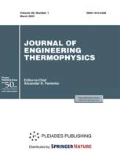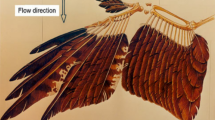Abstract
In this paper, the aerodynamic performance of the S series of wind turbine airfoils with different relative cambers and their modifications is numerically studied to facilitate a greater understanding of the effects of relative camber on the aerodynamic performance improvement of asymmetrical blunt trailing-edge modification. The mathematical expression of the blunt trailing-edge modification profile is established using the cubic spline function, and S812, S816 and S830 airfoils are modified to be asymmetrical blunt trailing-edge airfoils with different thicknesses. The prediction capabilities of two turbulence models, the k-ω SST model and the S-A model, are assessed. It is observed that the k-ω SST model predicts the lift and drag coefficients of S812 airfoil more accurately through comparison with experimental data. The best trailing-edge thickness and thickness distribution ratio are obtained by comparing the aerodynamic performance of the modifications with different trailing-edge thicknesses and distribution ratios. It is, furthermore, investigated that the aerodynamic performance of original airfoils and their modifications with the best thickness of 2% c and distribution ratio being 0:4 so as to analyze the increments of lift and drag coefficients and lift–drag ratio. Results indicate that with the increase of relative camber, there are relatively small differences in the lift coefficient increments of airfoils whose relative cambers are less than 1.81%, and the lift coefficient increment of airfoil with the relative camber more than 1.81% obviously decreases for the angle of attack less than 6.3°. The drag coefficient increment of S830 airfoil is higher than that of S816 airfoil, and those of these two airfoils mainly decrease with the angle of attack. The average lift–drag ratio increment of S816 airfoil with the relative camber of 1.81% at different angles of attack ranging from 0.1° to 20.2° is the largest, closely followed by S812 airfoil. The lift–drag ratio increment of S830 airfoil is negative as the angle of attack exceeds 0.1°. Thus, the airfoil with medium camber is more suited to the asymmetrical blunt trailing-edge modification.
Similar content being viewed by others
References
Li, X.X., Yang, K., Zhang, L., Bai, J.Y., and Zhao, X.L., Design of Large Thickness Airfoil with Blunt Trailing Edge, J. Eng. Therm., 2014, vol. 35, no. 9, pp. 1744–1748.
Roth-Johnson, P., Wirz, R.E., and Lin, E., Structural Design of Spars for 100-m Biplane Wind Turbine Blades, Renew. Energ., 2014, vol. 71, pp. 133–155.
Andersen, P.B., Gaunaa,M., Bak, C., and Buhl, T., Load Alleviation onWind Turbine Blades Using Variable Airfoil Geometry, Wind Eng., 2005, vol. 29, no. 2, pp. 169–182.
Mayda, E.A., van Dam, C.P., Chao, D.D., and Berg, D.E., Computational Design and Analysis of Flatback Airfoil Wind Tunnel Experiment, Albuquerque: Sandia National Laboratories, 2008.
Jackson, K.J., Zuteck, M.D., van Dam, C.P., Standish, K.J., and Berry, D., Innovative Design Approaches for Large Wind Turbine Blades, Wind Eng., 2005, vol. 8, no. 2, pp. 141–171.
Baker, J.P., Mayda, E.A., and van Dam, C.P., Experimental Analysis of Thick Blunt Trailing-Edge Wind Turbine Airfoils, J. Sol. Eng.-T ASME, 2006, vol. 128, no. 4, pp. 422–431.
Standish, K.J. and van Dam, C.P., Aerodynamic Analysis of Blunt Trailing Edge Airfoils, J. Sol. Eng.-T ASME, 2003, vol. 125, no. 4, pp. 479–487.
Singh, R.K., Rafiuddin Ahmed, M., and Zullah, A., Design of a Low Reynolds Number Airfoil for Small Horizontal Axis Wind Turbines, Renew. Eng., 2012, vol. 42, pp. 66–76.
Singh, R.K. and Rafiuddin Ahmed, M., Blade Design and Performance Testing of a Small Wind Turbine Rotor for LowWind Speed Applications, Renew. Eng., 2013, vol. 50, pp. 812–819.
Chao, D.D. and van Dam, C.P., Computational Aerodynamic Analysis of a Blunt Trailing-Edge Airfoil Modification to the NREL Phase VI Rotor, Wind Eng., 2007, vol. 10, no. 6, pp. 529–550.
Deng, L., Qiao, Z.D., Yang, X.D., and Xiong, J.T., Aerodynamics Performance Computational of Trailing-Edge-Blunting Methods of Flatback Airfoil for Large Wind Turbine Based on RANS Equation, Acta Energiae Solaris Sinica, 2012, vol. 33, no. 4, pp. 545–551.
Xu, H.R., Yang, H., and Liu, C., Numerical Value Analysis on Aerodynamic Performance of DU Series Airfoils with Thickened Trailing Edge, Transact. Chinese Soc. Agricult. Eng., 2014, vol. 30, no. 17, pp. 101–108.
Li, R.N., Yuan, S.K., and Zhao, Z.Q., Research on the Effect of Trail-Edge Improvement on Airfoils Performance for Wind Turbine, Acta Aerodynam. Sinica, 2012, vol. 30, no. 5, pp. 646–652.
Shen, Z.H. and Yu, G.L., Influence of Airfoil’s Camber on the Performance ofWind Turbines, J. Power Eng., 2007, vol. 27, no. 1, pp. 136–139.
Shen, Z.H., Yu, G.L., Shen, H.Y., and Zhu, W.X., The Experimental Study of Enhancement ofWind Turbine Performance by Increasing Blade Camber, Acta Energiae Solaris Sinica, 2007, vol. 28, no. 8, pp. 830–833.
Larsen, J.W., Nielsena, S.R.K., and Krenk, S., Dynamic Stall Model for Wind Turbine Airfoils, J. Fluid Struct., 2007, vol. 23, pp. 959–982.
Li, R.N., Zhang, S.A., Yang, R., and Li, D.S., Effect of AerofoilCamber on Airfoil Aerodynamic Performance, Fluid Machin., 2009, vol. 37, no. 5, pp. 17–21.
Chen, J., Wang, Q., Pang, X.P., Li, S.L., and Guo, X.F., Improvement of Airfoil Design Using Smooth Curvature Technique, Renew. Eng., 2013, vol. 51, pp. 426–435.
Mohamed, M.H., Ali, A.M., and Hafiz, A.A., CFD Analysis for H-Rotor Darrieus Turbine as a Low Speed Wind Energy Converter, Eng. Sci. Technol. Int. J., 2015, vol. 18, no. 1, pp. 1–13.
Yang, H., Shen, W.Z., Xu, H.R., Hong, Z.D., and Liu, C., Prediction of the Wind Turbine Performance by Using BEM with Airfoil Data Extracted from CFD, Renew. Eng., 2014, vol. 70, pp. 107–115.
Choudhry, A., Arjomandi, M., and Kelso, R., A Study of Long Separation Bubble on Thick Airfoils and Its Consequent Effects, Int. J. Heat Fluid Fl., 2015, vol. 52, pp. 84–96.
Ramsay, R.R. and Gregorek, G.M., Effects of Grit Roughness and Pitch Oscillations on the S812 Airfoil, Golden, Colorado: National Renewable Energy Laboratory, 1998.
Li, C., Zhu, S.Y., Xu, Y.L., and Xiao, Y.Q., 2.5D Large Eddy Simulation of Vertical Axis Wind Turbine in Consideration of High Angle of Attack Flow, Renew. Eng., 2013, vol. 51, pp. 317–330.
Pauley, L.L., Moin, P., and Reynolds, W.C., The Structure of Two-Dimensional Separation, J. Fluid Mech., 1990, vol. 220, pp. 397–411.
Author information
Authors and Affiliations
Corresponding author
Rights and permissions
About this article
Cite this article
Zhang, X., Wang, G.G., Zhang, M.J. et al. Effect of relative camber on the aerodynamic performance improvement of asymmetrical blunt trailing-edge modification. J. Engin. Thermophys. 26, 514–531 (2017). https://doi.org/10.1134/S1810232817040075
Received:
Published:
Issue Date:
DOI: https://doi.org/10.1134/S1810232817040075




